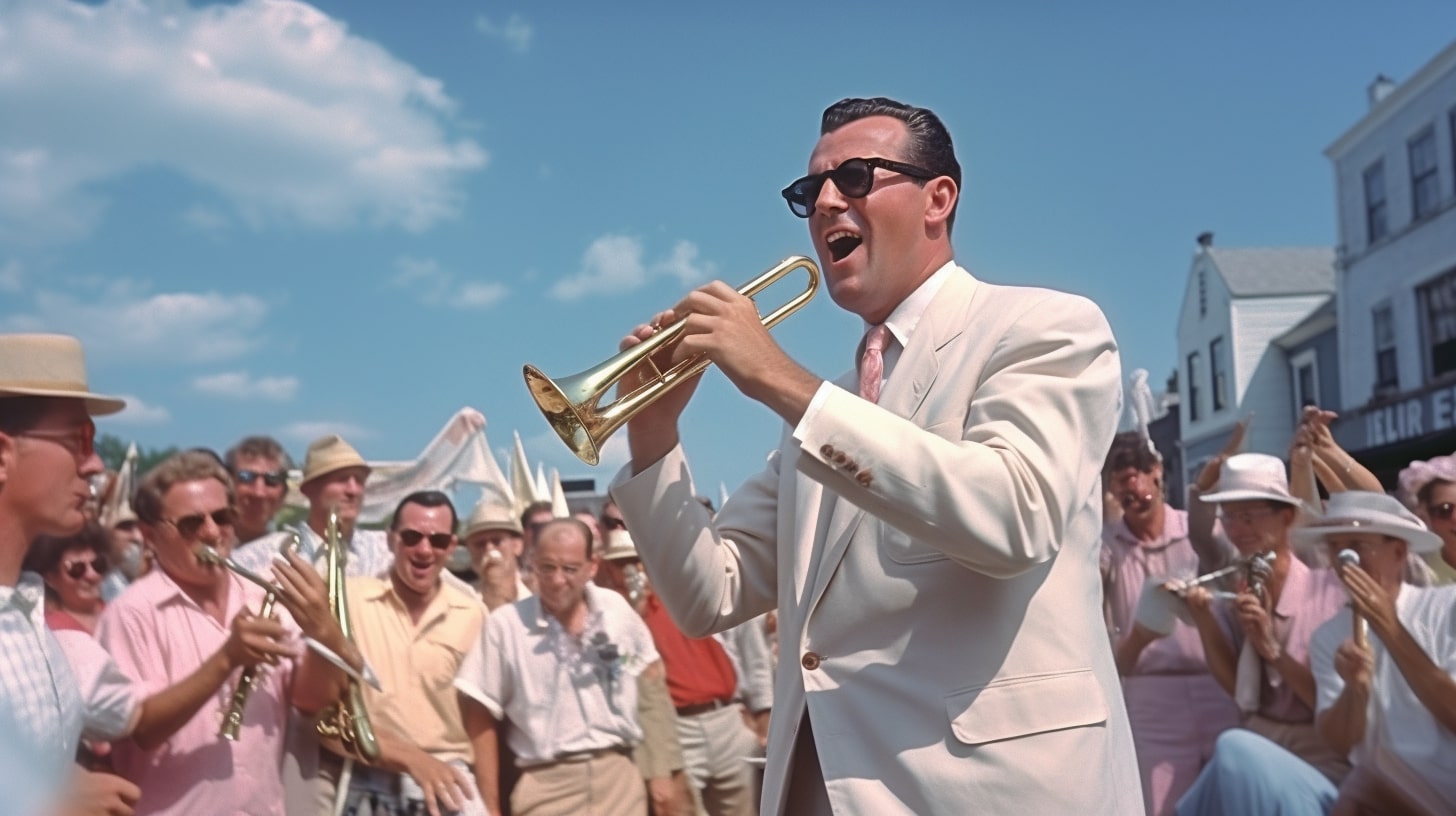Glenn Miller, a renowned bandleader, and musician, was known for his exceptional skills and innovation in the world of music during the swing era.
The unique sound of Miller’s orchestra can be attributed to his ability to seamlessly blend various instruments.
Contents
Glenn Miller’s Early Life and Career
Birthplace and Family
Glenn Miller was born Alton Glen Miller on March 1, 1904, in Clarinda, Iowa. He was the son of Mattie Lou (née Cavender) Miller and Lewis Elmer Miller and added the second n to “Glenn” during his high school days. Glenn grew up with his siblings Elmer Deane, John Herbert, and Emma Irene.
First Steps in Music
Growing up in Iowa, Miller took to music at a young age and started out by playing the mandolin. However, he soon traded the mandolin for a trombone as his interest began to lean more toward brass instruments.
University of Colorado
Miller attended the University of Colorado for a brief period in the early 1920s but left before completing his degree. Although Miller’s time at the university wasn’t particularly significant in terms of his musical career, it was an early stepping stone that allowed him to explore different paths.
From Mandolin to Trombone
As mentioned earlier, Miller initially began his musical journey with the mandolin but quickly transitioned to the trombone. This decision would ultimately shape the rest of his music career. Trombone became Miller’s primary instrument and played a key role in establishing his signature sound as a bandleader.
Ben Pollack’s Band
In the late 1920s, Miller joined Ben Pollack’s Band, which proved to be a career-defining move for him. This experience allowed him to hone his skills as a trombonist and musician, eventually leading to his own successful career as a bandleader in the swing and big band era of the 1930s and 1940s.
The Glenn Miller Orchestra
Formation and Success
Glenn Miller, a talented trombonist, and musician, formed his orchestra in 1938. The unique sound of the Glenn Miller Orchestra was characterized by a clarinet playing the melody, doubled by a tenor saxophone playing an octave lower, with other saxophones providing harmonic support.
As a big band, it quickly gained popularity and became one of the most successful dance orchestras of the swing era.
Notable Performances and Venues
In 1939, the Glenn Miller Orchestra performed at the Glen Island Casino in New York, which marked the beginning of their rise to fame. They would later perform at various other venues, showcasing their skill and captivating audiences with their unique sound.
Hit Songs and Albums
The orchestra produced numerous hit songs, with several reaching the top of the charts. Some of their most famous compositions include:
- “Moonlight Serenade,” which became the orchestra’s signature tune
- “In the Mood,” a lively and iconic swing piece
- “Chattanooga Choo Choo,” from the movie Sun Valley Serenade
- “Tuxedo Junction,” another chart-topping hit
- “A String of Pearls,” showcasing their proficient musicianship
The Glenn Miller Orchestra recorded several successful albums under the RCA Victor label, leaving a lasting impact on the big band and swing music scene. Their music was also featured in films such as Orchestra Wives and Sun Valley Serenade, further contributing to their popularity.
The Glenn Miller Orchestra’s unique sound and impressive list of hit songs continue to be celebrated today, making them an important part of American music history.
Collaborations and Relationships
Fellow Musicians and Arrangers
Glenn Miller, a renowned trombone player, had a notable impact on the music industry, particularly in the realm of swing music. Miller worked or collaborated with various fellow musicians, including significant figures like Ray Noble, Tommy Dorsey, Jimmy Dorsey, Tex Beneke, Artie Shaw, and Louis Armstrong. These collaborations helped shape the distinctive sound that became synonymous with Glenn Miller and his orchestra, creating timeless compositions such as “String of Pearls.”
Throughout his career, Miller focused on honing his skills in arranging and composing, fostering strong relationships with fellow musicians and arrangers. These connections helped elevate his work and contributed to the lasting influence of his music.
Military Career and Wartime Efforts
During his successful career, Miller enlisted in the Second World War. He joined the United States Army Air Forces, where his talent was recognized, and was assigned to lead the Army Air Force Band. Miller’s contributions during this time period significantly improved the morale of troops, as his music became synonymous with the American spirit and determination showcased during World War II.
Glenn Miller’s military career saw him perform for soldiers in different locations, earning him the respect and admiration of both the military and the public. His wartime efforts further cemented his status as a symbol of the World War II generation.
During his military service, he made connections within the Army Air Forces, collaborating with other talented musicians to develop compositions that would resonate with the soldiers and boost their morale.
It was during this time that Glenn Miller’s music played an essential role in the lives of those affected by the war, providing a source of comfort and inspiration in times of turmoil.
Miller’s Disappearance and Legacy
Missing in Action
The Glenn Miller story is both tragic and inspiring. Born on March 1, 1904, in Clarinda, Iowa, he went on to become a symbol of the World War II generation through his music. Tragically, Glenn Miller lost his life at the age of 40 when his airplane disappeared en route from London to Paris on December 16, 1944. His disappearance occurred somewhere over the English Channel when he was aboard a military plane.
To this day, the circumstances surrounding Miller’s disappearance remain an unsolved mystery. As a result, Miller was classified as Missing in Action (MIA) during World War II.
Posthumous Releases and Recognitions
Despite his tragic disappearance, Glenn Miller’s music and legacy continued to gain recognition even after his death. Numerous posthumous releases of Miller’s recordings and compilations helped to cement his status as a pivotal figure in the music world. Additionally, Miller was honored with the title of ‘MIA’ in Arlington National Cemetery to pay tribute to his service during the war.
Influences on Swing and Big Band Music
Glenn Miller was regarded as one of the most popular bandleaders of the late 1930s and early 1940s. He played a critical role in shaping the swing and big band music styles during this era. Miller’s compositions and arrangements were innovative and elevated the status of these genres within the American music landscape.
Museum and Memorials
To celebrate the life and accomplishments of Glenn Miller, several memorials and museums have been dedicated to him. One of the primary institutions is the Glenn Miller Birthplace Museum, located in his birthplace of Clarinda, Iowa. This museum showcases Miller’s personal artifacts and musical instruments and offers a glimpse into his life and career.
Additionally, Miller’s name is inscribed within Arlington National Cemetery as a tribute to his service and contributions during World War II.
Discovering Glenn Miller’s Music
Instruments of the Orchestra
Glenn Miller was known for his work in the big-band jazz and swing genres. His orchestra, Glenn Miller and His Orchestra, was formed in 1938 and became the most popular and commercially successful dance orchestra of the swing era.
The band had a unique arrangement, including a clarinet and tenor saxophone playing the melody, three other saxophones playing harmony, trumpets, trombones, a horn section, a pianist, and a rhythm section.
Classic Songs to Listen To
Some of Glenn Miller’s most iconic songs that showcase his talent and the orchestra’s unique arrangement include:
- “In the Mood” (1939)
- “Moonlight Serenade” (1939)
- “Tuxedo Junction” (1940)
- “Chattanooga Choo Choo” (1941)
- “A String of Pearls” (1942)
These songs highlight the different instruments used in the orchestra, such as the clarinet, saxophones, horn, trumpet, and trombones.
Filmography
A biographical film titled “The Glenn Miller Story” was released in 1954, directed by Anthony Mann and starring James Stewart as Glenn Miller. The film showcased Miller’s life, from his humble beginnings in a small-town orchestra to his rise as a bandleader and his eventual untimely death.
The film also highlighted the various instruments and musical arrangements that were key to Miller’s signature sound, including the trombone, clarinet, saxophones, and other key components of a big band orchestra.


